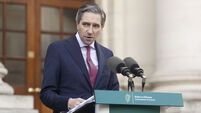Seamus Coffey: 'We are living a way within our means'

Seamus Coffey: 'An advantage of a national reserve fund is that it provides funds that could be accessed if the country was to lose access to borrowing money on financial markets.'
As a country we find ourselves in an uncommon position: We are living a way within our means.
Recent figures from the Central Statistics Office show the net flow of income in and out of the country was positive to the tune of €20bn.











